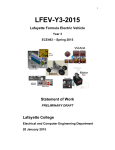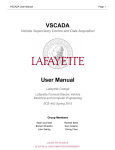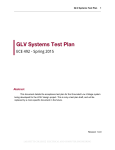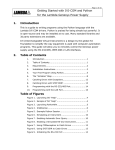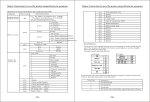Download D002: User`s Manual - Sites at Lafayette
Transcript
User’s Manual ECE 492 – Spring 2014 Latest Revision: 13 May 2014 Prepared by: Ben Richards Abstract This document outlines the user-level procedures for operating the LFEV-ESCM2014 System. USER’S MANUAL 1 Table of Contents INTRODUCTION......................................................................................................................... 3 SAFETY ......................................................................................................................................... 3 IDENTIFICATION OF SYSTEM COMPONENTS................................................................. 4 PACK ............................................................................................................................................... 4 CHARGER ........................................................................................................................................ 5 INTERFACES .................................................................................................................................... 5 CABLES ........................................................................................................................................... 6 THEORY OF OPERATION ....................................................................................................... 8 TSV/GLV SEPARATION ................................................................................................................. 8 SAFETY LOOP ................................................................................................................................. 8 SYSTEM OPERATION ............................................................................................................... 9 CONFIGURATION ............................................................................................................................ 9 DISCHARGE ................................................................................................................................... 10 1. PACK STATUS AND SET-UP ......................................................................................................... 10 2. DISCHARGE ................................................................................................................................ 10 3. TEAR-DOWN ............................................................................................................................... 10 CHARGE ........................................................................................................................................ 11 1. PACK STATUS AND SET-UP ......................................................................................................... 11 2. CHARGING ................................................................................................................................. 11 3. CHARGE TERMINATION .............................................................................................................. 12 TROUBLESHOOTING ............................................................................................................. 13 USER’S MANUAL 2 ERROR CODES .............................................................................................................................. 13 SERVICE ..................................................................................................................................... 15 CHARGING FUSES ......................................................................................................................... 15 DISCHARGING FUSE ..................................................................................................................... 16 USER’S MANUAL 3 Introduction The LFEV-ESCM as delivered in 2014 consists of a 7-cell electrochemical accumulator pack designed to provide energy to an electric Formula SAE vehicle, and a charger to replenish the energy of the accumulator. This user's manual covers the normal operation and basic troubleshooting of the system. Safety As with all electrical devices, safety is of primary concern when handling and operating the LFEVESCM system. Please note the following safety precautions: Wear safety glasses at all times when operating or maintaining the system. The accumulator cells store a large amount of energy, and careless behavior can cause this energy to dissipate extremely quickly in the form of electric shock, arc, explosion, or other violent and potentially destructive ways. This energy discharge can cause collateral damage and personal injury, including electric shock and burns. Beware of pinch points on the pack, including access panels and connector junctions. The pack weighs in excess of 50 pounds (22 kg). Because of the size and shape, it should only be moved by two people. Certain pack components may become hot during operation. This is expected and anticipated as part of the design. These components are not normally directly accessible, though the exterior of the pack may still become warm as a result. These components are marked with yellow thermally-activated labels that display the word "HOT" or an image (such as a hand) in orange when the surface temperature of the component is 50°C or higher. NOTE: This equipment has been tested and found to comply with the limits for a Class A digital device, pursuant to part 15 of the FCC Rules. These limits are designed to provide reasonable protection against harmful interference when the equipment is operated in a commercial environment. This equipment generates, uses, and can radiate radio frequency energy and, if not installed and used in accordance with the instruction manual, may cause harmful interference to radio communications. Operation of this equipment in a residential area is likely to cause harmful interference in which case the user will be required to correct the interference at his own expense. USER’S MANUAL 4 Identification of System Components Pack The accumulator pack (hereafter, "pack") is show in Figure 1. Each LiFePo cell (A) has a nominal voltage of 3.2 volts and a nominal capacity of 60 amp-hours, for an overall pack voltage of 22.4 volts. The pack also contains two charging fuses (B) and one discharge fuse (C) to protect the pack in case of accidental short circuit. Accumulator isolation relays (hereafter "AIRs") (D) prevent unauthorized discharge of the pack. The charging and discharging of the pack is completely selfmanaged and monitored by an integrated, low-power industrial computer system (E). 4 USER’S MANUAL 5 Charger The TDK-Lambda GENH30-25 is an off-the-shelf, UL-listed commercial power supply which produces up to 30 volts DC at up to 25 amps. Its parameters can be set directly using the front panel controls, or remotely using an RS-232 link. Basic operation as pertinent to the LFEV system will be outlined in this user's manual. Complete, detailed operating instructions and product specifications may be found in the GENESYS 750W HALF RACK Technical Manual, available at http://www.us.tdk-lambda.com/hp/pdfs/Product_manuals/835075002.pdf TM (as of 14 May 2014) The pigtail (below) attached to the rear of the charger provides a convenient connection for the charging cable. This pigtail is semi-permanently attached and should not be removed except as required in the event of system repair or maintenance. Interfaces The following connectors and controls are present on the pack: High-current discharge connectors: These are the large blue connectors located on the top of the pack at each end. The positive (TSV+) and negative (TSV-) terminals are marked. Safety Loop connectors (2): These are the white, 4-pin connectors located on the top of the pack at each end. The connectors are electrically identical and either one may be used when a reference to "safety loop" is made in this manual. USER’S MANUAL 6 RS-485 connector: This is the white, 6-pin connector on the top of the pack at the negative end. This connector provides an RS-485 link to a data acquisition system (not provided) when installed in the Formula SAE vehicle. Charging connector: This is the multi-colored Anderson PowerPole connector located on the top of the pack at the negative end. This connector is used to provide charging current to the pack, and as part of the safety loop when the pack is not being charged. Cables The following cables are included with the system: Charging Cable: This is a 2-conductor cable assembly which provides the charging current path from the charger to the pack. This cable is identified by Anderson PowerPole connectors on both ends. USER’S MANUAL 7 RS-485 to PC adapter: This cable consists of two components. The first is a commercially available RS-485 to USB adapter, available from the ECE Department Lab Coordinator. The second is a 6-pin to 6-pin cable. The following cables are not included with the system because their exact configuration varies based on the application. The system maintenance manual gives detailed information about electrical specifications and pinouts of these connectors PIC-Kit3 In-Circuit Programmer: This is used to load firmware onto the BMS boards. It is not used during normal operation. For further details refer to the System Maintenance Manual. Discharging cables (Not Shown): These cables connect the pack to other packs and/or a load. They attach to the high-current discharge connectors. LCD Display The pack includes a 20x4-character LCD display which indicates the pack status. Each of the four lines contains specific information about the pack. The character "X" indicates a numerical value. Line 1: "PACMAN 2014 - NMH" o This is the name of the program and the initials of the author. Line 2: "SOC: XX [DIS]CHARGING o This line shows the estimated state-of-charge of the pack, and the state of the current path (either charging or discharging). Line 3: C: XX V: XX.XX o This line shows the current (in amps) and the voltage (in volts) of the overall pack. A negative current value indicates energy is flowing out of the pack. A positive current value indicates energy is flowing into the pack. Line 4: EXX: [error message] o This line shows status messages that are relevant to pack operation, including notifications and error conditions. Examples may include "Low Pack Voltage" or "Charging Completed". USER’S MANUAL 8 Theory of Operation This battery pack is designed for use in the Formula SAE Hybrid competition as part of the Lafayette Formula Electric Vehicle. As much as possible, the pack is designed to be an autonomous unit. It includes an internal computer which monitors the pack and controls charge and discharge. This computer (referred to as "PacMan", short for Pack Manager") is powered by the pack itself and runs at all times, except in the case that the pack is depleted so far that insufficient voltage remains to keep the system powered up. For reliability, the complete system software, including a distribution of the Linux operating system, is located on a removable microSD card in the computer. System software usage and configuration are covered in later sections of this manual. TSV/GLV Separation The system is divided electrically into two segments: Tractive System Voltage (TSV) and Grounded Low Voltage (GLV). From the Formula SAE Rules: EV1.1.3 The Tractive System of the car is defined as every part that is electrically connected to the motor(s) and accumulators. EV1.1.4 The Grounded Low Voltage System of the car is defined as every electrical part that is not connected to the tractive system. This is primarily intended to enhance the safety of the system by preventing short circuit conditions which could result in sudden high-energy discharge of the accumulators. In case of fault in one system or the other, the safety of the user is not threatened by such a sudden high-energy electrical discharge. Safety Loop To enable complete isolation of the accumulators from the rest of the system, two accumulator isolation relays are installed in each pack. These relays are of the normally-open type and prevent TSV from being present outside the pack when the pack is not in operation. Furthermore, the Formula SAE Rules specify a shutdown circuit (EV5.1) which will activate these relays, referred to herein as the "safety loop". Installed in the vehicle are several devices which are capable of opening the safety loop for a variety of reasons. The safety loop supplies current directly to the AIRs to keep them closed. If the safety loop is broken, the AIRs are opened, and the pack is immediately isolated from every other component on the vehicle. USER’S MANUAL 9 System Operation IMPORTANT: Before operating the system, note the safety precautions in the front of this manual. Configuration The system is designed for flexibility to allow adjustments to system parameters. These adjustments are made in a configuration file which is located on the PacMan SD card. The parameters as delivered should provide acceptable performance; however, the system configuration can be changed in a number of ways: 1. Configure the system using ssh. a. Connect the pack to a network using the ethernet port. b. Use ssh access to edit the config file using a text editor. 2. Directly edit the config file using another PC. a. Open the pack. b. Remove the microSD card and access it using another PC. System calibration and operating parameters are found in the configuration file on the PacMan. This file is located at ~/PM14/PM14.cfg on the PacMan computer. Note the use of configuration variables 'a' and 'b' throughout the file. These are calibration coefficients used to correct the system sensor readings. 'a' is the scaling factor, and 'b' is the bias. When components such as AMS boards are swapped, the calibration parameters must be updated to match. See the System Calibration document for information about how to calculate calibration parameters. Note that the I2C addresses in this configuration file are 7 bits. The LSB (R/W') is not specified as part of this address. To convert the 7-bit address into a standard 8-bit address, multiply the address by 0x02. Search Google for "I2C protocol" and refer to the Interface Control Document for more information about I2C communication. The first section of the config file contains electrical and thermal safety parameters for the cells. These are obtained from the manufacturer's datasheet and should not be modified without consulting the LFEV-ESCM Engineering team. The value of "log file" in the second section enables or disables data logging to a file called "out.dat" The third and fourth sections contain the 7-bit I2C addresses and calibration coefficients for the current sensors. Together, this pair of sensors measures current into and out of the cells. USER’S MANUAL 10 The fifth section contains the 7-bit I2C addresses and calibration coefficients for the AMS boards. Discharge Discharge is defined as any procedure for which the AIRs are closed and current is drawn from the discharge connectors. The following steps outline the discharge procedure. 1. Pack Status and Set-up To ensure that the pack is in an appropriate state for discharging, the LCD should not display any error code. If the LCD displays an error code, see the "Troubleshooting" section before proceeding. Once the pack is in the correct state, connections should be made as follows: 1. Attach the pack to the safety loop using both safety loop connectors by pushing each plug straight in until it clicks. As the name implies, the loop must be closed for proper operation. If only one safety loop connector is used, the other connector must be filled with a "dummy" plug to close the safety loop. 2. Attach the RS-485 communication link to the pack, if this link is used, by pushing the plug straight in until it clicks. This connection serves for data acquisition purposes only. The pack will be able to discharge with or without this connection. 3. Attach the safety plug to the charge port by pushing the connector straight in until it clicks. If the charge cable is connected to the pack, it must be removed and replaced with the safety plug before the pack can be discharged. 4. With the load switched off, attach the load to the pack using both high-current discharge connectors by pushing each plug straight on, then rotating clockwise until it clicks. 2. Discharge The system is now ready to be discharged. 1. Activate the safety loop. The AIRs should close with an audible click. 2. Connect the load to AC mains, if applicable, and switch on the load. The current drawn through the pack will be displayed on the LCD screen. 3. In case of emergency, stop discharge immediately by de-activating the safety loop. 4. The pack will continue to discharge until a safety threshold is violated in the pack, such as low cell voltage or high temperature. 5. If an error occurs, the safety loop will open and the discharge will stop. The safety loop cannot be reactivated until the error condition is resolved. See the "Troubleshooting" section for error code descriptions. 3. Tear-down 1. Switch off the load. The high-current connectors must not be disconnected while the pack is under load. USER’S MANUAL 11 2. De-activate the safety loop. The AIRs should not be opened under load except in emergency situations, i.e. the safety loop is tripped. 3. Disconnect the safety loop connectors, the RS-485 link, and the discharge connectors. 4. Disconnect the load from AC mains, if applicable. 5. Store the pack safely and securely. Charge A charger of the proper voltage and current capacity must be used. The charger must put out no more than 25A at 30VDC, and must be of the "constant-current" type. The preferred charger is the TDKLambda GENH30-25 supplied with the system, which meets these requirements. An alternate power supply may instead be used to charge the pack, provided that it meets the voltage and current requirements of the pack. For more information about using alternate chargers, see the System Maintenance Manual. 1. Pack Status and Set-up IMPORTANT: The pack cannot be simultaneously charged and discharged. Removing the safety plug from the charge port will immediately open the safety loop. To ensure that the pack is in an appropriate state for charging, the LCD should not display any error code. If the LCD displays an error code, see the "Troubleshooting" section before proceeding. Once the pack is in the correct state, connections should be made as follows: 1. Attach the AC mains cable to the charger, and plug it into a grounded, 120VAC wall socket. 2. Turn on the AC mains power switch located on the charger. 3. Attach the RS-485 communication link to the pack, if this link is used, by pushing the plug straight in until it clicks. This connection serves for data acquisition purposes only. The pack will be able to charge with or without this connection. 4. Remove the dummy plug from the charge port on the pack. This opens the safety loop, ensuring that the pack cannot be discharged while it is charging. 5. Attach the charge cable to the charger by pushing one end of the charge cable straight into the charger pigtail socket until it clicks. 6. Attach the other end of the charge cable to the pack by pushing the connector straight into the socket until it clicks. 2. Charging 1. The PacMan will automatically detect the presence of a charger. In case the pack has been depleted so far that the integrated computer has shut down, the computer must boot before charging can begin. See "Dead Pack" in the Troubleshooting section for more details on this special case. USER’S MANUAL 12 2. When the PacMan detects a charger connection, the charge relays will close and the pack will begin to charge. This is indicated on the LCD screen by the word "Charging" and the charge current readout in amps. 3. As soon as voltage is present at the charger inputs, the pack cooling fan will turn on. This fan operates only during pack charging, to exhaust heat produced by the cell-balancing circuitry. It is a convenient indicator of the presence of charging voltage at the pack connector. If the fan does not turn on when the charger is connected, one of the charge fuses may be blown. See the Troubleshooting section. 3. Charge Termination 1. When the system determines that the pack is fully charged, the charging relays will open and "Charging Complete" will display on the LCD. The flow of current to the cells will be stopped, but the fan will remain in operation. 2. If the charger is disconnected at any time before the PacMan determines that charge is complete, charge will be terminated. 3. If an error condition occurs in the pack, the error will be displayed on the LCD and charge will be terminated. Once the error has been corrected, charging will not resume automatically. The charger must be disconnected and reconnected to resume charging. USER’S MANUAL 13 Troubleshooting Error Codes The LCD displays information about the state of the system. The following error codes may appear in the fourth line of the LCD. In all cases, refer to the Software section of the System Maintenance Manual if a fix is not readily apparent. E01: There is a problem with the system configuration file. The system will not operate until the config file is corrected. E03: This means the connection has been lost or cannot be established with one or more of the AMS boards specified in the configuration file. The safety loop will open and the system will not charge or discharge when this occurs. To resolve this issue, follow these steps: 1. Check the addresses in the configuration file to ensure they match the actual AMS addresses. 2. Check the physical connections of the communication bus. See the System Maintenance Manual for details. E05: This means the temperature of some component is out of the safe operating range. The safety loop will open. To correct this error, try to identify the faulty component by observing the yellow "HOT" stickers. These display orange regions when the surface to which they are affixed is above 50°C. Let the pack cool, and check the system logs to positively identify the overheated component. E06: This means the voltage of one or more cells is too low to allow continued discharge of the pack. The safety loop will open, and the pack must be charged before this error will clear. E07: This means an unexpected error has occurred, possibly due to hardware fault or file system corruption. Check the system logs for clues as to what went wrong. Dead Pack The pack provides nominal 24VDC output during normal operation. The low-voltage safety threshold is around 2.5VDC per cell, or 17.5VDC for the pack. The PacMan computer can continue to operate at voltages well below this value, down to 5VDC. However, the pack should not be allowed to discharge to such a low level, as the LiFePo cells are damaged by this deep discharge. In case this deep discharge occurs and the PacMan has shut down, the following special steps must be taken to restore operation: 4 1. Open the pack by removing the side panel. 2. Remove the two AMS boards from the extreme ends of the pack. USER’S MANUAL 14 3. Connect two hookup wires with banana plugs to a power supply capable of 30 volts DC. 4. Connect one hookup wire to the positive-most battery terminal and one to the negative-most battery terminal. 5. Zero the outputs of the power supply and turn it on. 6. Increase the voltage of the power supply until the pack begins to draw current. A low current (about 5 amps DC) is sufficient to revive the cells, and reduces the risk of further cell damage. 7. Allow the pack to charge for 15 minutes. IMPORTANT: Do not allow the pack to charge for a long period in this fashion! The PacMan will not be able to disconnect the charger when charge is complete, resulting in an unsafe pack! 8. After 15 minutes, disconnect the hookup wires and replace the AMS boards. 9. Close the pack, replacing the side panel. 10. Connect the charge cable to the charge connector on the top of the pack. 11. Allow the pack to finish charging normally. USER’S MANUAL 15 Service The system is carefully engineered for performance, efficiency, and safety. As such, it is highly complex, and major repair or disassembly requires a thorough understanding of design principles. Nevertheless, there are user-serviceable parts which can be replaced without a large effort and without requiring extensive system knowledge. Charging Fuses These fuses protect the charging circuit. If a blown charging fuse is suspected, perform these steps: 1. Disconnect all connectors from the pack: a. Safety Loop b. RS-485 c. Ethernet d. Discharge connectors e. Charge connector 2. Remove the end cap from the fuse holder by rotating counterclockwise, then pulling straight out. The fuse will come out with the cap. 3. If the fuse cartridge is broken or damaged, it is possible that small shards of material are lodged in the holder. In this case, the entire fuse holder should be replaced. See the System Maintenance Manual for instructions. 4. The fuse is a 30-amp, 3AB ceramic-tube type cartridge fuse. Because the fuse element cannot be visually inspected, the fuse must be continuity-tested with a multimeter. 5. If the fuse reads <1 ohm, it is still good. 6. If the fuse reads >1 ohm, it is blown and must be replaced. 7. If the fuse is blown, it must be replaced only by Littelfuse part number 0505030.MXP or equivalent. This fuse has a 500V, 20kA DC interrupt rating which is necessary to ensure full protection of the system and operator. IMPORTANT: Although physically interchangeable, standard 3AG glass-tube fuses available at hardware stores are NOT acceptable substitutes in this system. 8. If the fuse is good, re-install it by placing it in the end cap and replacing the end cap in the holder. The fuse can be inserted either direction. The other fuse should be inspected in the same fashion. USER’S MANUAL 16 Discharging Fuse This fuse protects the primary tractive system current path. If a blown discharging fuse is suspected, perform these steps: 1. Disconnect all connectors from the pack: a. Safety Loop b. RS-485 c. Ethernet d. Discharge connectors e. Charge connector 2. Face the pack so the negative terminal is on your right. Remove the side enclosure panel or Lexan display panel. The fuse holder is accessible only from this side. 3. Remove the two bolts holding the fuse to the holder using an insulated wrench. Take care to keep track of the bolts and washers. 4. The fuse is a 200-amp Class T fuse. Because the fuse element cannot be visually inspected, the fuse must be continuity-tested with a multimeter. 5. If the fuse reads <1 ohm, it is still good. 6. If the fuse reads >1 ohm, it is blown and must be replaced. 7. If the fuse is blown, it must be replaced only by Mersen part number A3T200. This fuse has a 160V, 50kA DC interrupt rating which is necessary to ensure full protection of the system and the operator. 8. If the fuse is good, re-install it by attaching it to the fuse holder using the bolts and washers removed in Step 2.




















